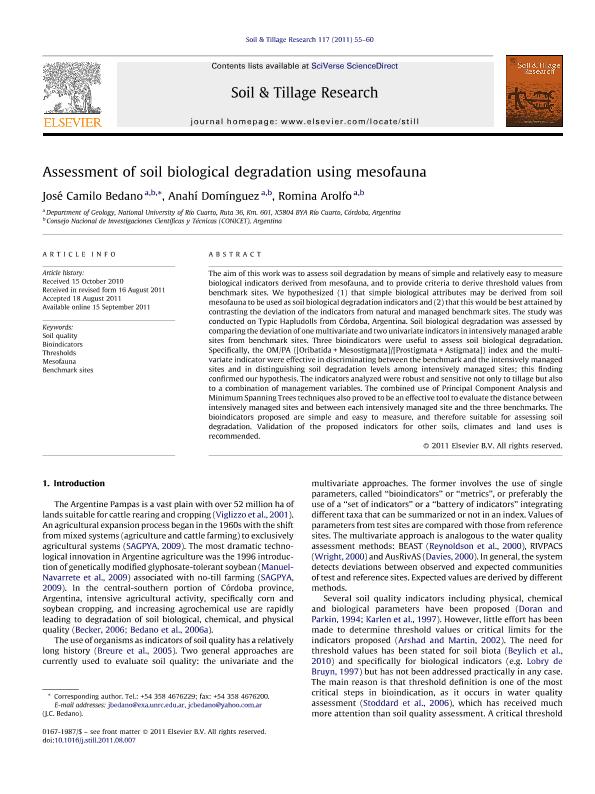Mostrar el registro sencillo del ítem
dc.contributor.author
Bedano, José Camilo

dc.contributor.author
Domínguez, Anahí

dc.contributor.author
Arolfo, Romina Vanesa

dc.date.available
2023-03-14T11:08:37Z
dc.date.issued
2011-09
dc.identifier.citation
Bedano, José Camilo; Domínguez, Anahí; Arolfo, Romina Vanesa; Assessment of soil biological degradation using mesofauna; Elsevier Science; Soil & Tillage Research; 117; 9-2011; 55-60
dc.identifier.issn
0167-1987
dc.identifier.uri
http://hdl.handle.net/11336/190427
dc.description.abstract
The aim of this work was to assess soil degradation by means of simple and relatively easy to measure biological indicators derived from mesofauna, and to provide criteria to derive threshold values from benchmark sites. We hypothesized (1) that simple biological attributes may be derived from soil mesofauna to be used as soil biological degradation indicators and (2) that this would be best attained by contrasting the deviation of the indicators from natural and managed benchmark sites. The study was conducted on Typic Hapludolls from Córdoba, Argentina. Soil biological degradation was assessed by comparing the deviation of one multivariate and two univariate indicators in intensively managed arable sites from benchmark sites. Three bioindicators were useful to assess soil biological degradation. Specifically, the OM/PA ([Oribatida + Mesostigmata]/[Prostigmata + Astigmata]) index and the multivariate indicator were effective in discriminating between the benchmark and the intensively managed sites and in distinguishing soil degradation levels among intensively managed sites; this finding confirmed our hypothesis. The indicators analyzed were robust and sensitive not only to tillage but also to a combination of management variables. The combined use of Principal Component Analysis and Minimum Spanning Trees techniques also proved to be an effective tool to evaluate the distance between intensively managed sites and between each intensively managed site and the three benchmarks. The bioindicators proposed are simple and easy to measure, and therefore suitable for assessing soil degradation. Validation of the proposed indicators for other soils, climates and land uses is recommended.
dc.format
application/pdf
dc.language.iso
eng
dc.publisher
Elsevier Science

dc.rights
info:eu-repo/semantics/openAccess
dc.rights.uri
https://creativecommons.org/licenses/by-nc-sa/2.5/ar/
dc.subject
BENCHMARK SITES
dc.subject
BIOINDICATORS
dc.subject
MESOFAUNA
dc.subject
SOIL QUALITY
dc.subject
THRESHOLDS
dc.subject.classification
Ecología

dc.subject.classification
Ciencias Biológicas

dc.subject.classification
CIENCIAS NATURALES Y EXACTAS

dc.title
Assessment of soil biological degradation using mesofauna
dc.type
info:eu-repo/semantics/article
dc.type
info:ar-repo/semantics/artículo
dc.type
info:eu-repo/semantics/publishedVersion
dc.date.updated
2023-03-10T14:30:55Z
dc.journal.volume
117
dc.journal.pagination
55-60
dc.journal.pais
Países Bajos

dc.journal.ciudad
Amsterdam
dc.description.fil
Fil: Bedano, José Camilo. Universidad Nacional de Río Cuarto; Argentina. Consejo Nacional de Investigaciones Científicas y Técnicas. Centro Científico Tecnológico Conicet - Córdoba; Argentina
dc.description.fil
Fil: Domínguez, Anahí. Universidad Nacional de Río Cuarto; Argentina. Consejo Nacional de Investigaciones Científicas y Técnicas. Centro Científico Tecnológico Conicet - Córdoba; Argentina
dc.description.fil
Fil: Arolfo, Romina Vanesa. Universidad Nacional de Río Cuarto; Argentina. Consejo Nacional de Investigaciones Científicas y Técnicas. Centro Científico Tecnológico Conicet - Córdoba; Argentina
dc.journal.title
Soil & Tillage Research

dc.relation.alternativeid
info:eu-repo/semantics/altIdentifier/url/https://www.sciencedirect.com/science/article/pii/S0167198711001413
dc.relation.alternativeid
info:eu-repo/semantics/altIdentifier/doi/http://dx.doi.org/10.1016/j.still.2011.08.007
Archivos asociados
